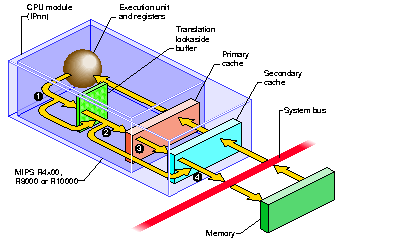Next | Prev | Up | Top | Contents | Index
CPU Access to Memory
The CPU generates the address of data that it needs--the address of an instruction to fetch, or the address of an operand of an instruction. It requests the data through a mechanism that is depicted in simplified form in Figure 1-1.

Figure 1-1 : CPU Access to Memory
- The address of the needed data is formed in the processor execution or instruction-fetch unit. Most addresses are then mapped from virtual to real through the Translation Lookaside Buffer (TLB). Certain ranges of addresses are not mapped, and bypass the TLB.
- Most addresses are presented to the primary cache, the cache in the processor chip. If a copy of the data with that address is found, it is returned immediately. Certain address ranges are never cached; these addresses pass directly to the bus.
- When the primary cache does not contain the data, the address is presented to the secondary cache. If it contains a copy of the data, the data is returned immediately. The size and the architecture of the secondary cache differ from one CPU model to another, and some CPUs do not have a secondary cache.
- The address is placed on the system bus. The memory module that recognizes the address places the data on the bus.
Next | Prev | Up | Top | Contents | Index

